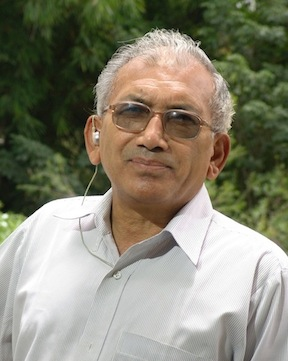Khadg Singh Valdiya
Khadg Singh Valdiya is an eminent Indian geologist known for his significant contributions to the field of geology, particularly in the areas of Himalayan geology, environmental geology, and Quaternary geology. Born on March 20, 1937, in Muzaffarnagar, Uttar Pradesh, Valdiya's work has been instrumental in advancing the understanding of the geological structure and processes of the Himalayas, including the study of earthquakes, landslides, and the environmental implications of geological activities.
Early Life and Education[edit | edit source]
Khadg Singh Valdiya's interest in geology began at an early age, leading him to pursue a Bachelor of Science degree in geology from Lucknow University. He furthered his education with a Master's degree and eventually earned his Ph.D. in geology, focusing on the geology of the Kumaun Himalayas, a topic that would remain central to much of his future research.
Career[edit | edit source]
Valdiya's academic career began at the University of Rajasthan, where he served as a faculty member before moving to the Kumaun University in Nainital. At Kumaun University, he was instrumental in establishing the Department of Geology, serving as its first head and later as the Vice-Chancellor of the university. His leadership and vision were pivotal in promoting geology as a vital field of study in India, particularly in understanding the complex geological phenomena of the Himalayan region.
Throughout his career, Valdiya has been recognized for his extensive field research, which has contributed significantly to the understanding of the geological history and dynamics of the Himalayas. His work on the geodynamics of the Himalayan region, including the processes of mountain building, erosion, and climate interactions, has been widely cited and has contributed to the global understanding of mountain geology.
Contributions and Legacy[edit | edit source]
Valdiya's contributions to geology extend beyond his research. He has authored several books and numerous research papers that are considered foundational texts in Himalayan and environmental geology. His ability to communicate complex geological concepts to a broader audience has made his work accessible to students, researchers, and the general public alike.
One of Valdiya's notable contributions is his research on the paleoseismicity of the Himalayan region, which has implications for understanding the earthquake potential and risks in this densely populated and seismically active area. His studies on the environmental impact of geological processes have also contributed to the development of sustainable practices in the region.
Awards and Honors[edit | edit source]
Khadg Singh Valdiya has received numerous awards and honors in recognition of his contributions to geology. These include prestigious awards from various scientific and academic institutions, reflecting his status as a leading figure in the field of geology.
Conclusion[edit | edit source]
Khadg Singh Valdiya's work has had a profound impact on the field of geology, particularly in the study of the Himalayas. His research has not only advanced the scientific understanding of this critical region but has also played a key role in promoting environmental sustainability and disaster preparedness. As a scholar, educator, and researcher, Valdiya's legacy in the geological sciences continues to influence new generations of geologists and environmental scientists.
Navigation: Wellness - Encyclopedia - Health topics - Disease Index - Drugs - World Directory - Gray's Anatomy - Keto diet - Recipes
Search WikiMD
Ad.Tired of being Overweight? Try W8MD's physician weight loss program.
Semaglutide (Ozempic / Wegovy and Tirzepatide (Mounjaro / Zepbound) available.
Advertise on WikiMD
WikiMD is not a substitute for professional medical advice. See full disclaimer.
Credits:Most images are courtesy of Wikimedia commons, and templates Wikipedia, licensed under CC BY SA or similar.Contributors: Prab R. Tumpati, MD

